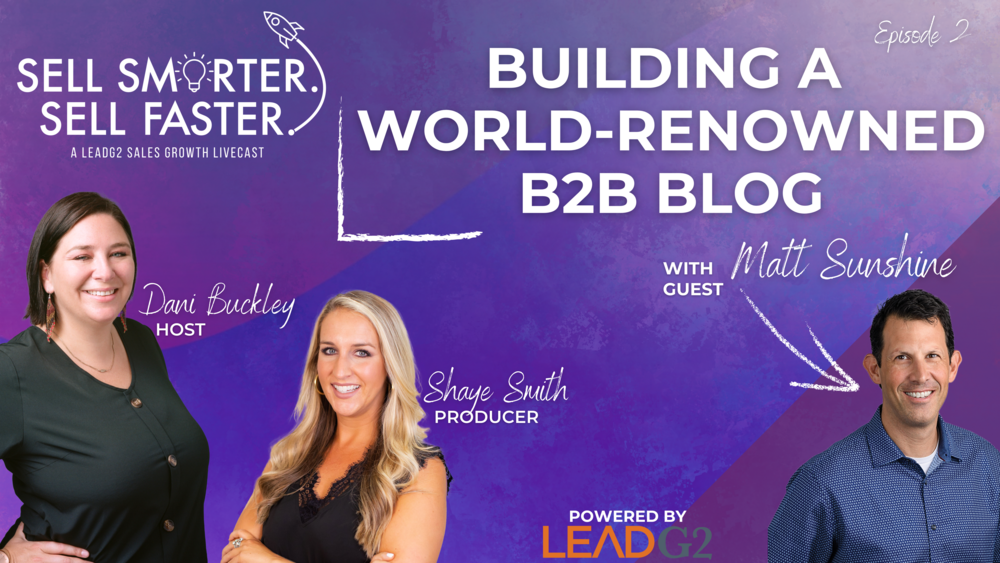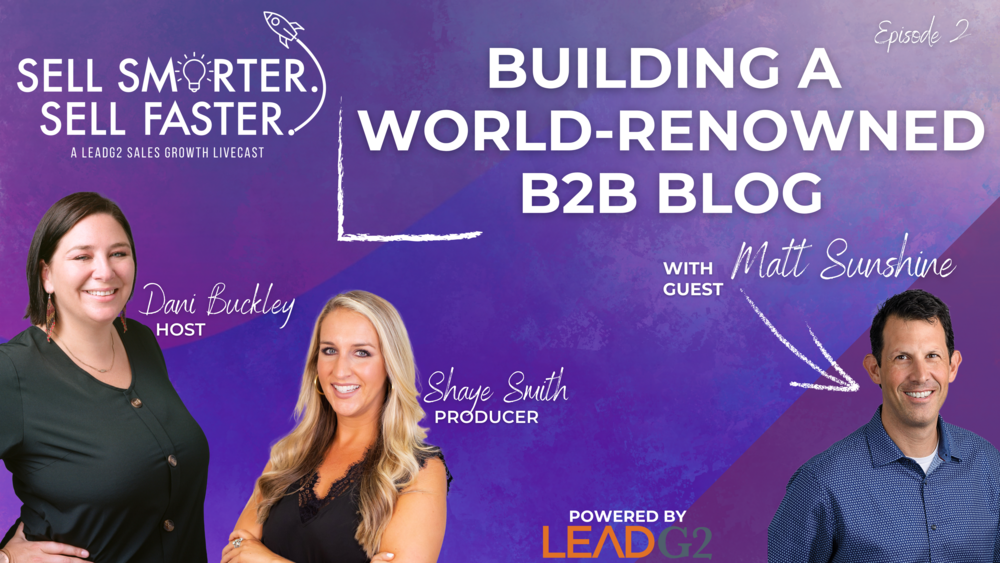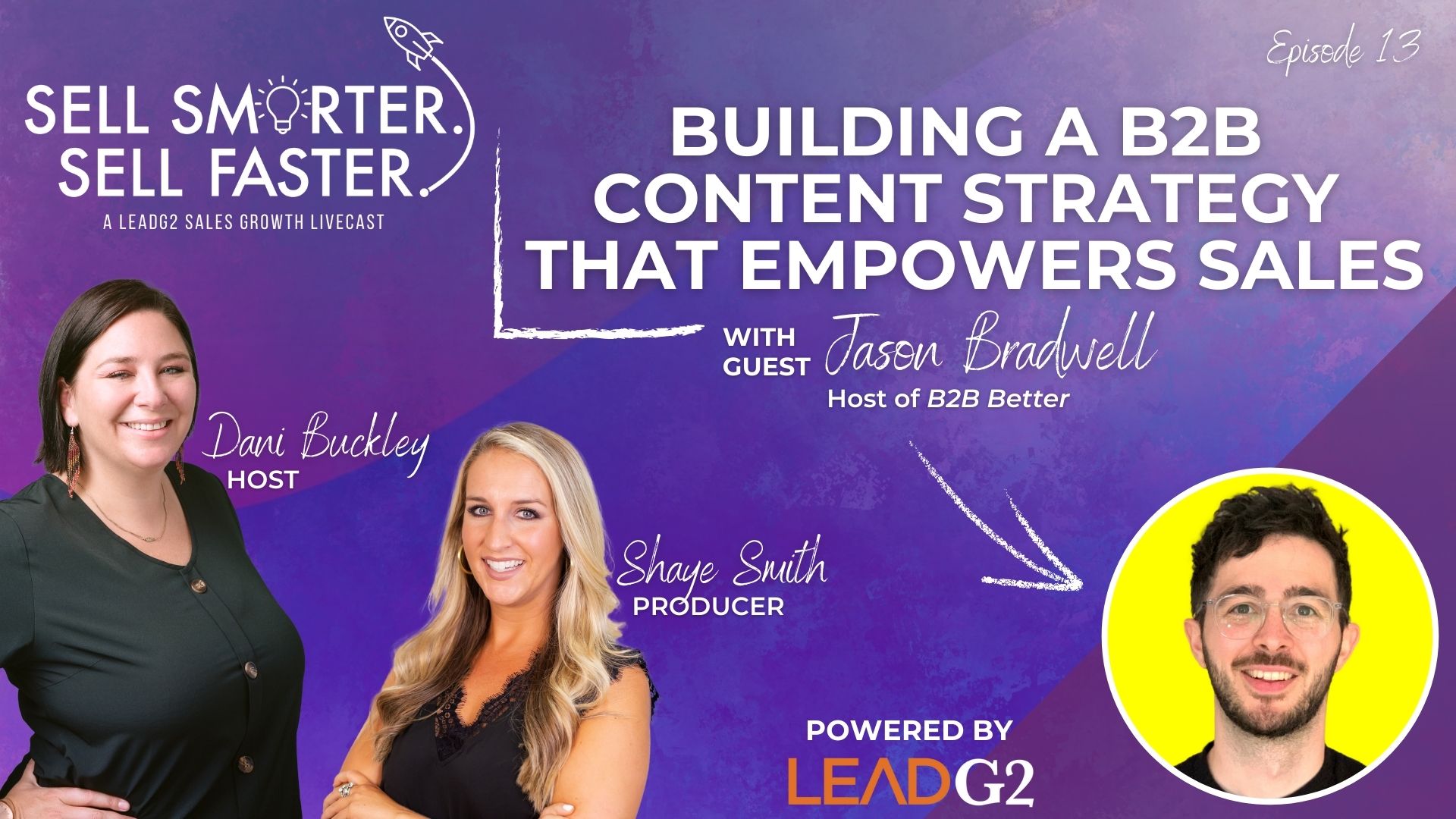How to Make Sure Your B2B Content is Converting
Creating compelling B2B content is only half the battle when it comes to a solid content marketing strategy for your business. While your content...
6 min read
 Amanda Meade
:
August 17, 2021
Amanda Meade
:
August 17, 2021


How do you start a B2B blog? And WHY do you start a B2B blog?
Episode 2 of Sell Smarter. Sell Faster. explored building a world-renowned B2B blog from the ground-up with guest Matt Sunshine, Managing Partner at The Center for Sales Strategy.
Throughout the episode, host Dani Buckley and Matt discussed how a strong, educational, and impactful blog has impacted lead generation, the sales process, and overall sales performance for The Center for Sales Strategy, as well as real-life examples of a B2B blog in action.
Tune in now or keep reading for a brief overview.
Blogging is often considered a task for the marketing division. However, B2B blogs are a sales initiative, and the goal is to drive leads, develop thought leadership, and ultimately, produce more sales and more conversions and enable the sales process.
As Dani points out, blogging is part of inbound marketing strategy, and all the best sales organizations have both outbound and inbound strategies.
“You want to have different ways that leads come in and ways for prospects to find you online and easily connect and engage,” she explains. “Meanwhile, you want your great, smart, talented salespeople reaching out, making appointments, and doing what they do best.”
It’s important to have a balance of inbound and outbound marketing efforts. Both strategies serve a purpose. One doesn’t, and shouldn’t, replace the other. In fact, when properly deployed, inbound marketing will improve the results of your outbound marketing tactics, and outbound marketing will give a lift to the impact of your inbound marketing strategy.
Those who prioritize blogging efforts are 13x more likely to see positive ROI.
SEO leads have a 14.6% close rate compared to only 1.7% for outbound leads such as direct mail and print advertisements.
57% of marketers say they've gained customers specifically through blogging.
53% of marketers say blogging is their top content marketing priority.
B2B marketers that blog get 67% more leads than those that do not.
Business blogging leads to 55% more website visitors than those who do not.
Clearly, blogging fuels SEO efforts. The people who are looking for answers find you in their journey. This is the reason blogging has a larger conversion rate than outbound efforts.
At The Center for Sales Strategy (CSS), organic traffic is the number one driver to the website. Therefore, we’ve seen first-hand how successful blog content can be. In fact, LeadG2 was founded because our parent company (CSS) found such great success in blogging and wanted to help clients do the same.
Matt Sunshine is a Managing Partner at the Center for Sales Strategy, a sales performance company that helps sales organizations attract, retain, and develop the highest performing salespeople.
Matt’s areas of expertise include growing sales organizations, finding and developing sales superstars, sales process, lead generation, inbound marketing, and digital marketing, and he is a featured writer for one of the top sales blogs in America and a regular contributor to leading business blogs and magazines such as Inc., Sales and Marketing Management, Sales Hacker, Entrepreneur.
In 2012, Matt developed and launched LeadG2, an Inbound Marketing company that helps businesses establish thought leadership and lower lead costs. LeadG2 has earned the premier HubSpot recognition as a Diamond Certified Partner.
Matt is the author of “Getting Prospects to Raise Their Hand,” and Forbes magazine lists Matt as one of the 20 Speakers You Shouldn't Miss the Opportunity to See.
You can learn more about Matt and connect with him at MattSunshine.com.
The world-renowned B2B blog that Matt started, established, and grown collectively over the years now averages 48k to 50k views per month and has over 8,500 blog subscribers.
While these are impressive numbers, it’s taken a lot of work to achieve this success.
CSS is a sales performance company. The primary audience is sales leaders, salespeople, business owners, chief revenue officers—anyone highly accountable for driving revenue for their business.
“Our goal for the blog is to answer questions that these people have,” Matt explains. “We want to be helpful and do our part by contributing to their success. We think about the information that will help our clients and prospects – not just what we want to tell people.”
During the interview, Matt explains when starting the CSS blog, there was a big debate on what the company wanted to blog about and what they wanted it to be. They made the decision to have a blog that was more helpful than promotional, and with the understanding that not everything had to generate a lead.
“Even to this day, if we can’t live by that, then we shouldn’t blog at all,” states Matt.
The CSS blog started coming out of the 2008/2009 recession. “The company was doing fine, but when we looked at our situation, we had one client that represented almost half of our revenue,” Matt explains. “And that’s a scary place to be. We quickly determined we needed something to diversify our portfolio of clients.”
CSS narrowed down three areas of business:
Lead Generation
Selling Solutions
Delivering Services
“We found that we were not good at lead generation,” Matt states. “We were really good if we could get someone who has a need for what we did. We closed the majority of those accounts and retained well over 90% of business year in and year out, so we didn’t have a problem selling solutions. We didn’t have a problem with delivering results – we had a problem with lead generation.”
Matt explains how the company wanted to grow revenue, get more leads, nurture all of the leads that were just sitting there. “We needed to be in front of them all the time.”
In the early stages of the CSS blog, there were roughly 50 followers. There wasn’t a content specialist to help write the blogs; it was Matt who took responsibility for the blog and reached out to the people within the company to help contribute.
By 2014, a big threshold was hit with 10k pageviews. In 2015, 15k pageviews, and in 2019, there were approximately 29k pageviews.
Over the last year, the pageviews for the CSS blog averages between 45k to 60k a month. “These are organic views,” states Matt. “It’s hard in the beginning, and you won’t see instant success. It takes a lot of patience and consistency.”
The blogs at CSS are written by people within the company. “We made the decision to have our people write blog content because our people have the best expertise,” explains Matt. “We know the common problems and questions that clients and prospects are asking, and we write about those.”
CSS does have an internal process where the marketing team shares keywords and topics with consultants. There’s also an editing and optimizing process. “It’s important to create a culture internally for blogging,” states Matt.
Matt says that one question he’s frequently asked is, “Aren’t you worried that if you give way expertise through blogging, that people won’t hire you?”
It’s a valid question, but the answer is absolutely not. As Matt states, “You are what you publish.”
When you consistently publish blog articles that are helpful to your audience, they begin viewing you as a thought leader. To them, you’re the expert. “As you steadily establish yourself as a thought leader in the industry, prospects will reach out when they’re ready,” Matt explains. “This is the WHY behind blogging. People have a hard time deciding WHY to get started than actually getting started.”
ALeadG2, we have several resources available that help guides you on how to get started with business blogging. Additionally, Matt wrote an entire book with exact details on how to get started.
During the interview, Matt gives two real-life examples of blogging ROI. These are examples you may not think about as ROI, and it’s rare to be this linear.
For the first example, Matt explains how a current client of CSS Google searched “digital needs analysis.” Working with a lot of media companies, and this being a common obstacle for them, CSS articles were some of the first to show on Google. “The guy noticed my name attached to the article, looked me up on LinkedIn, noticed I lived in Texas, and struck up a conversation with me.”
This client never filled out a form! And this is also an instance where CSS would have never fund this person relying strictly on outbound methods.
The second example Matt gives is about a prospect hat ghosted the team after a long process. “After being ghosted, I got an alert that this prospect downloaded an eBook on the CSS resource page,” Matt explains. “Because of this action, I contacted the consultant and asked for them to reach out to the prospect. That prospect quickly became a client, and still is!”
Blogging for business is a complex journey, but it’s proven that blogging and content do contribute to selling smarter and faster.
To end the livecast, Matt gives one piece of advice to listeners.
“Don’t do it on your own! I did it for a year on my own with no one to bounce ideas and wondering if I was doing it right. After the first year of results, I wish I would have hired someone to be my coach or mentor - not everyone is a good writer but they have good thoughts.”
Starting a business blog without help costs more money, takes longer, and you end up making more mistakes.
Don’t miss another episode of the Sell Smarter. Sell Faster. where Dani Buckley, VP/GM of LeadG2 speaks with experts and thought leaders across a variety of industries and learn how they implementer of some of the most proven sales enablement and inbound marketing tactics and strategies. Visit SellSmarterSellFaster.com to learn more.
Subscribe to our YouTube channel and have your notifications on so you’re notified of our next episode!
-273049-edited.jpg)
Creating compelling B2B content is only half the battle when it comes to a solid content marketing strategy for your business. While your content...

Why is content so important in the B2B space? Jason Bradwell, host of the B2B Better podcast, discusses building a B2B content strategy that empowers...

1 min read
As we kick off the new year, it's safe to say that content still reigns as king in the B2B world, and it seems that it's going to stay that way. With...